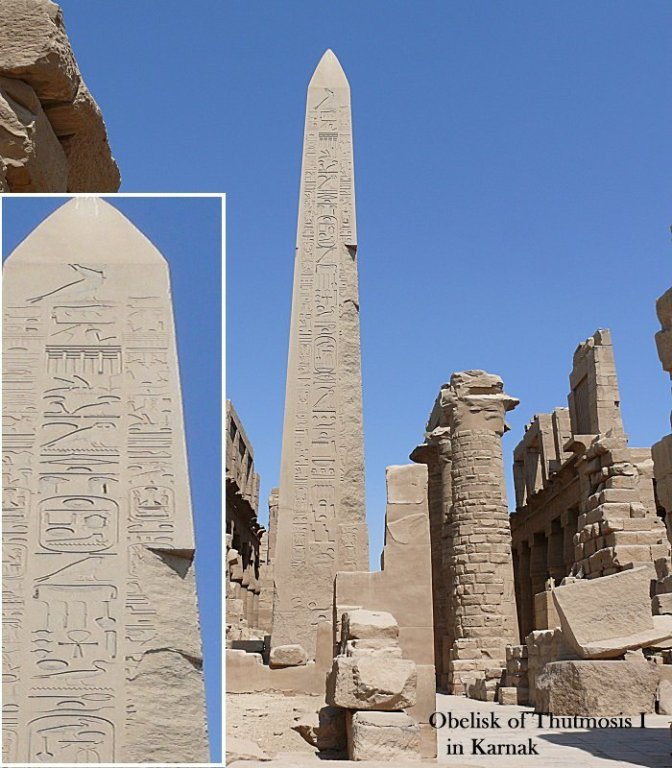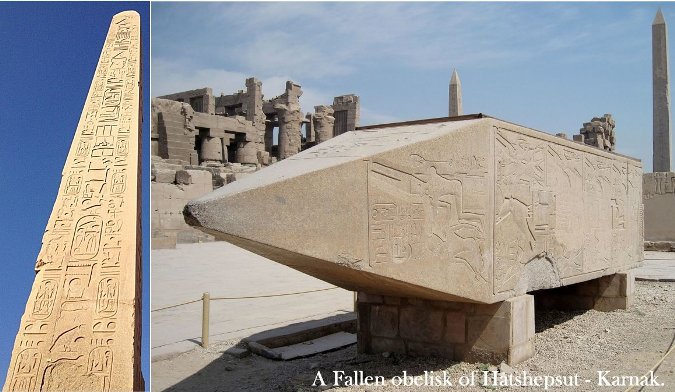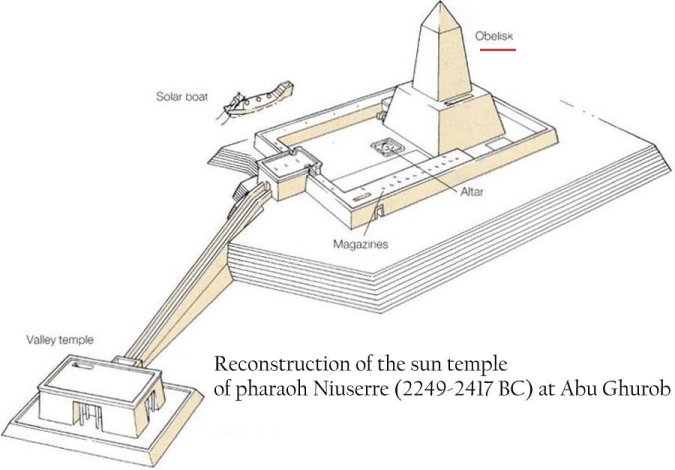It's hard to build a great Egyptian monument by hand, which secret technology did they use?
The history of huge polished granite monuments in Egypt is still enveloped in a mysterious veil.
The monument (obelisk) is a monolithic block of four faces, erect upright with the tip of a point, shaped like a small pyramid called pyramidion .

(Photo: Internet)
The monument is the symbol of the Sun God in ancient Egyptian beliefs and is often inlaid with gold. They are also often made into pairs.
What is the cause of establishing monuments?
It seems that this cause is ambiguous. In ancient Egypt, they played many different roles, such as praising the Pharaoh's victory.
" The monument is a gathering place, a place to help people connect spiritually with their sun god, Than Ra . " (Ch. Dunn)

Left: The granite monument of Pharaoh Hatshepsut at the Karnak temple in Luxor, built in 1457 BC, in the XVII dynasty.Right: The horizontal monument of Pharaoh Hatshepsut in Karnak.(Photos: Wikipedia)
It is believed that the oldest monument located in Abusir, erected during the reign of Pharaoh Niuserre (2249-2417 BC).

Reconstruction of the Temple of Pharaoh Niuserre's design at Abu Ghurob.(Photo: Internet)
Knowledge lost to the giant stone monuments
The monument has a long history, but knowledge of them, including advanced technology used to build them vertically, is now lost. The ancient monument is in monolithic form, which includes only a single stone.
Most modern monuments are assembled from several blocks. A prominent example is the Washington Monument in Washington, DC.

Washington Monument in Washington, USA.(Photo: Internet)
However, the ancient Egyptians had enough mechanical skills to carve and set up smaller monuments.
The oldest monuments are located near the crypt burial of kings, about 1 - 4 m high. The Egyptians called them "Tekhenu", an unknown term, but the phrase "tekhen" at the beginning means "piercing". It is believed that symbolically, the monument means "piercing" through the sky.
The monument is intended to worship the Sun or the guiding columns?
According to Greek historian Herodotus, these works are linked to the Sun. Specifically, they symbolize the "sun rays" and are often engraved on the surface of pictograms. In addition, a Roman writer and scholar named Pliny old (AD 23 - 79) once wrote that giant monuments in the "Pharaoh's Land" aim to worship the Sun and represent Sun icon.

One of the most famous monuments is still located at the entrance to the Luxor temple.(Photo: World Atlas)
Vivant Denon (1747 - 1825) was an French archaeologist, painter, writer, diplomat and author, who wrote " Journey in Upper and Lower Egypt " in 1802, a two-volume work. later became the foundation of modern Egyptology.
Denon thinks that the ancient Egyptian kings used monuments as a guide column "to inform certain things to their subjects for their benefit ."
The hieroglyphs appeared a long time ago
One of the most interesting hypotheses is that all the giant monuments, due to their impressive structure, have been discovered and reused by the Egyptians for other purposes, but they themselves are not institutionalists. Original stone blocks.
It is believed that all monuments created in monolithic form were created earlier than before much by an extremely advanced but unknown civilization . At that time, they were not engraved with hieroglyphs.
But it is also known that Queen Hatshepsut erected four monuments in the temple of Amun at Karnak. Two of them no longer exist until now and the other pair, including one that was spilled and a north monument, still stands at the original position. The monument is made of red granite and a block of pink granite. This is the second largest ancient monument in Egypt; with a height of 28.58 m and weighing up to 343 tons. It is located in the Great Temple worshiping Amon god, at Karnak.
At the time of the Pharaohs, many temples were built around the monument and pictograms began to appear on them.
To this day it is unclear how these gigantic hundreds-tonne structures are mined and transported then erected.
What kind of supernatural tool has been used by craftsmen, engineers and sculptors to carry out this design?
In the book "Lost technology of ancient Egypt: The advanced technology inside the Temple of Pharaohs", author Dunn said "no tools or machines existed until now. capable of producing this kind of work, what remains cannot reach such an accuracy level, especially on an industrial scale . "
- Why did Egyptian warriors cut the enemy's right hand?
- The amazing mystery of the Great Zimbabwe stone kingdom
- Decode the secret secret of the Egyptian mummy
- Temple of Madeleine
- Things that make you see how great the ancient Egyptians were
- Restoring Hue monument with traditional lime mortar technology
- Secret 'heavenly' about the mummy's body 2 ancient noble brothers
- Unusual heat in the Egyptian pyramid
- Theories about how to build pyramids in ancient Egypt
- Construction errors caused the Great Egyptian pyramid to deviate
- SMART Technology - A big step in medical surgery
- Announcing a special national monument of Go Thap
 The truth about the mysterious red-haired giant at Lovelock Cave
The truth about the mysterious red-haired giant at Lovelock Cave Inunaki Tunnel: The haunted road leading into Japan's 'village of death'
Inunaki Tunnel: The haunted road leading into Japan's 'village of death' The mystery of the phenomenon of human reflection before dying
The mystery of the phenomenon of human reflection before dying 6 mysterious phenomena, although science has been developed for a long time, still cannot be answered
6 mysterious phenomena, although science has been developed for a long time, still cannot be answered